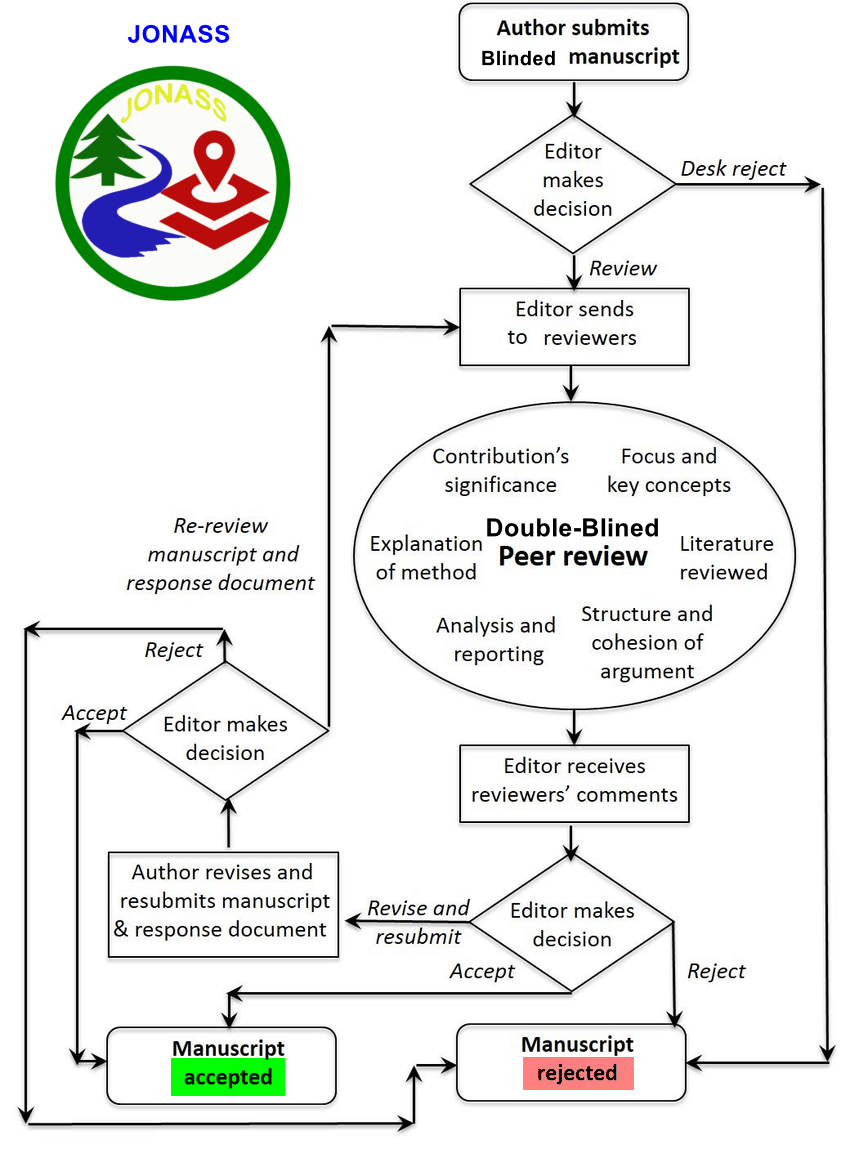Double-Blind Peer Review Processes and Guidelines
As of March 2021, this journal uses a double-blind review, which means that both the reviewer and author identities are concealed from the reviewers, and vice versa, throughout the review process.
To facilitate this, authors need to ensure that their manuscripts are prepared in a way that does not give away their identity. To help with this preparation, please ensure the following when submitting to JONASS:
Submit the Title Page containing the Author’s details and Blinded Manuscript with no author details as two separate files.
How to prepare the Title Page
This should include the title, authors' names and affiliations, and a complete address for the corresponding author, including telephone and e-mail address.
How to prepare the Blinded Manuscript
Besides the obvious need to remove names and affiliations under the title within the manuscript, other steps need to be taken to ensure the manuscript is correctly prepared for double-blind peer review. To assist with this process the key items that need to be observed are as follows:
- Use the third person to refer to work the Authors have previously undertaken, e.g. replace any phrases like “as we have shown before” with “… has been shown before [Anonymous, 2021]”.
- Make sure figures do not contain any affiliation-related identifier
- Do not eliminate essential self-references or other references, but limit self-references only to papers that are relevant for those reviewing the submitted paper.
- Cite papers published by the Author in the text as follows: ‘[Anonymous, 2021]’.
- For blinding in the reference list: ‘[Anonymous, 2021] Details omitted for double-blind reviewing.’
- Remove references to funding sources
- Do not include acknowledgments
- Remove any identifying information, including author names, from file names and ensure document properties are also anonymized.
Double-blind Peer review is the critical assessment of manuscripts submitted to journals by experts who are usually not part of the editorial staff. Because unbiased, independent, critical assessment is an intrinsic part of all scholarly work, including scientific research, peer review is an important extension of the scientific process. Peer review is intended to improve the accuracy, clarity, and completeness of published manuscripts and to help editors decide which manuscripts to publish. Peer review does not guarantee manuscript quality and does not reliably detect scientific misconduct. Peer reviewers advise editors on how a manuscript might be improved and on its priority for publication in that journal. Editors decide whether and under which conditions manuscripts are accepted for publication, assisted by reviewers’ advice. Editors of peer-reviewed journals need not send all submitted manuscripts out for review. Manuscripts that seem unlikely to be published in that journal may be returned to authors without external review, to allow authors to submit the manuscript to another journal without delay and to make efficient use of reviewers’ and editors’ time. Editors should also periodically publish statistics describing their journal’s review process, such as the number of manuscripts submitted, acceptance rate, and the average time from manuscript submission to rejection letter to authors and, for accepted manuscripts, time to publication.
The Journal of Nature and Spatial Sciences (JONASS) accepts submissions via its online submission system. The submitted manuscript must be accompanied by a cover letter in which the authors should state why the manuscript should be considered, evaluate any issues relating to the JONASS editorial policies, and declare if they have any competing interests. The authors of received manuscripts are also asked to submit a copyright declaration of competing interests as part of their manuscript.
Note: Reviews will be added to the Clarivate WoS accounts of reviewers if reviewers forward JONASS the Acknowledgement of Review (#JONASS) email to reviews@webofscience.com, See the sample. Also, your name will be added to the JONASS reviewer list.
Article submitted to the Journal is sent out to peer reviewers, although submissions that are out of the scope of the Journal or are of an unacceptably low standard may be rejected without review. Potentially suitable manuscripts will generally be reviewed by three experts in the field to reach a first decision as soon as possible. Specialist statistical advisers are used when necessary to ensure that the statistical reasoning in manuscripts is sound. Reviewers are asked to declare their competing interests if any. In JONASS there are APCs for the reviewing stage and publishing stages.
Editorial decisions are made based on the manuscript’s validity and coherence, as judged by the peer reviewers. In addition to their comments for the authors, reviewers are asked whether the research is sound and coherent, the topic interesting and the writing of acceptable quality. Where possible, the final decision is made on the basis that peer reviewers are in accordance with one another, or that at least there is no strong dissenting view. In cases where there is strong disagreement, either among the peer review or between the authors and the peer reviewers, the advice is sought from an editorial board member or a researcher of similar standing.
The detailed Journal peer review process is based on the following Flow Diagram:



